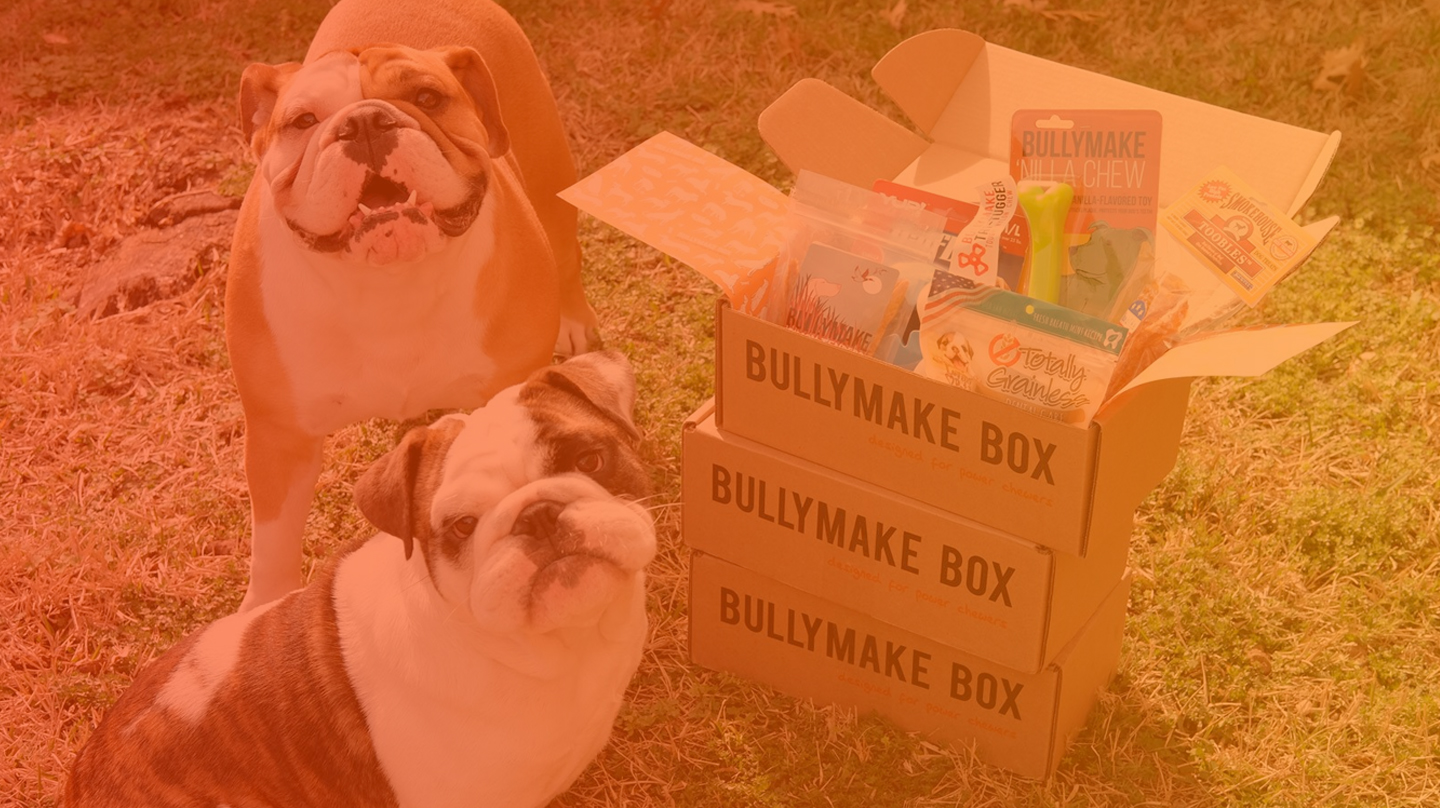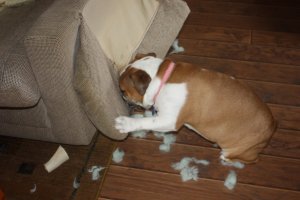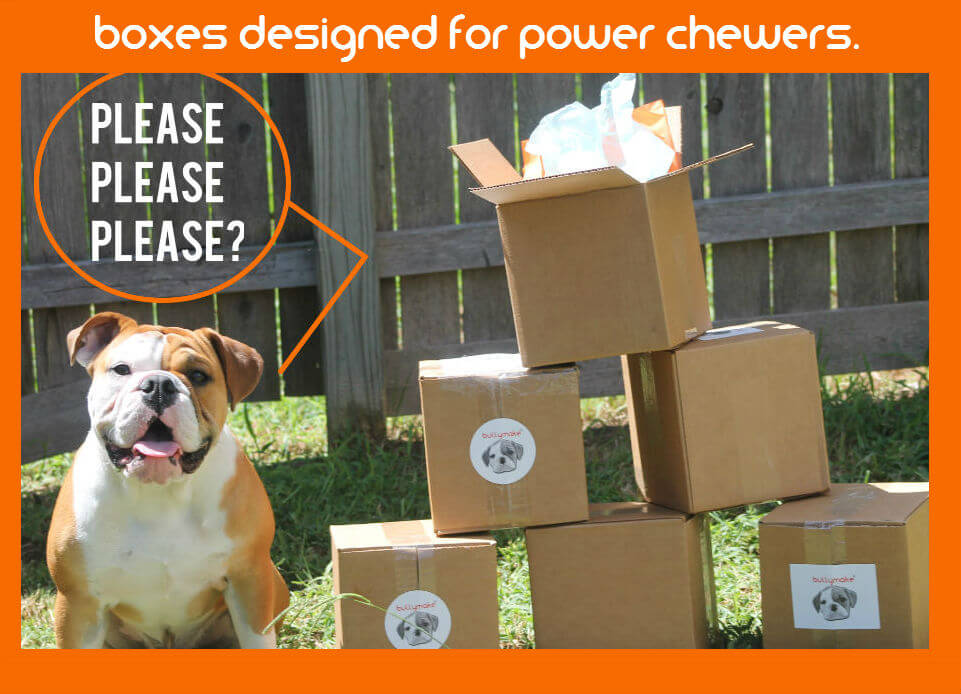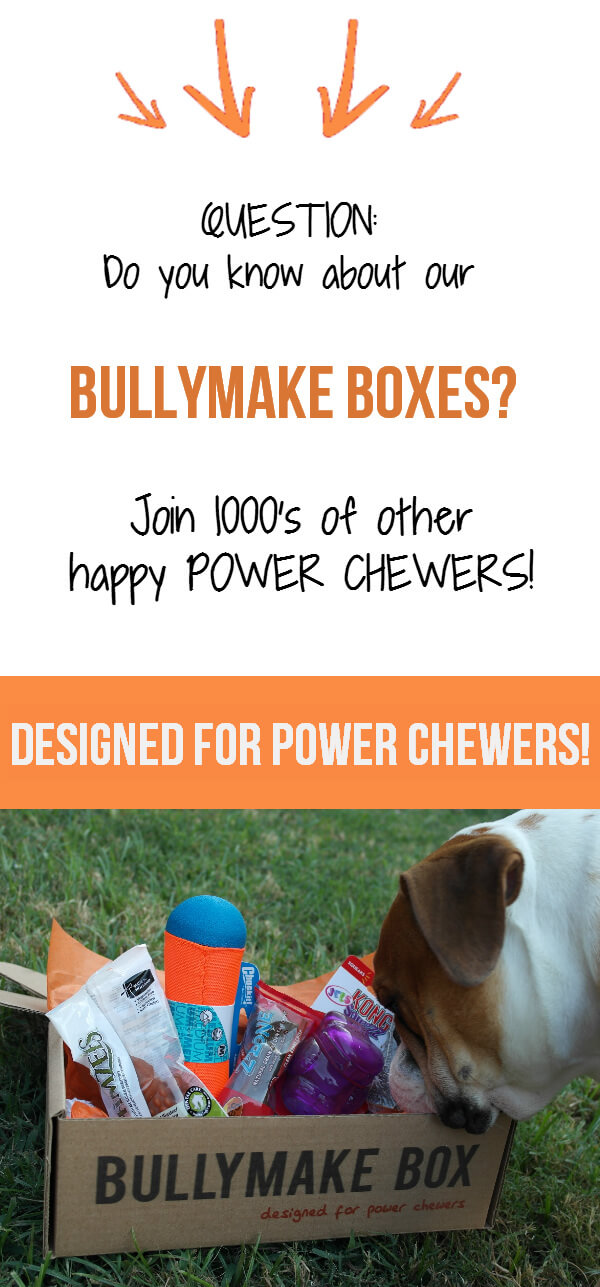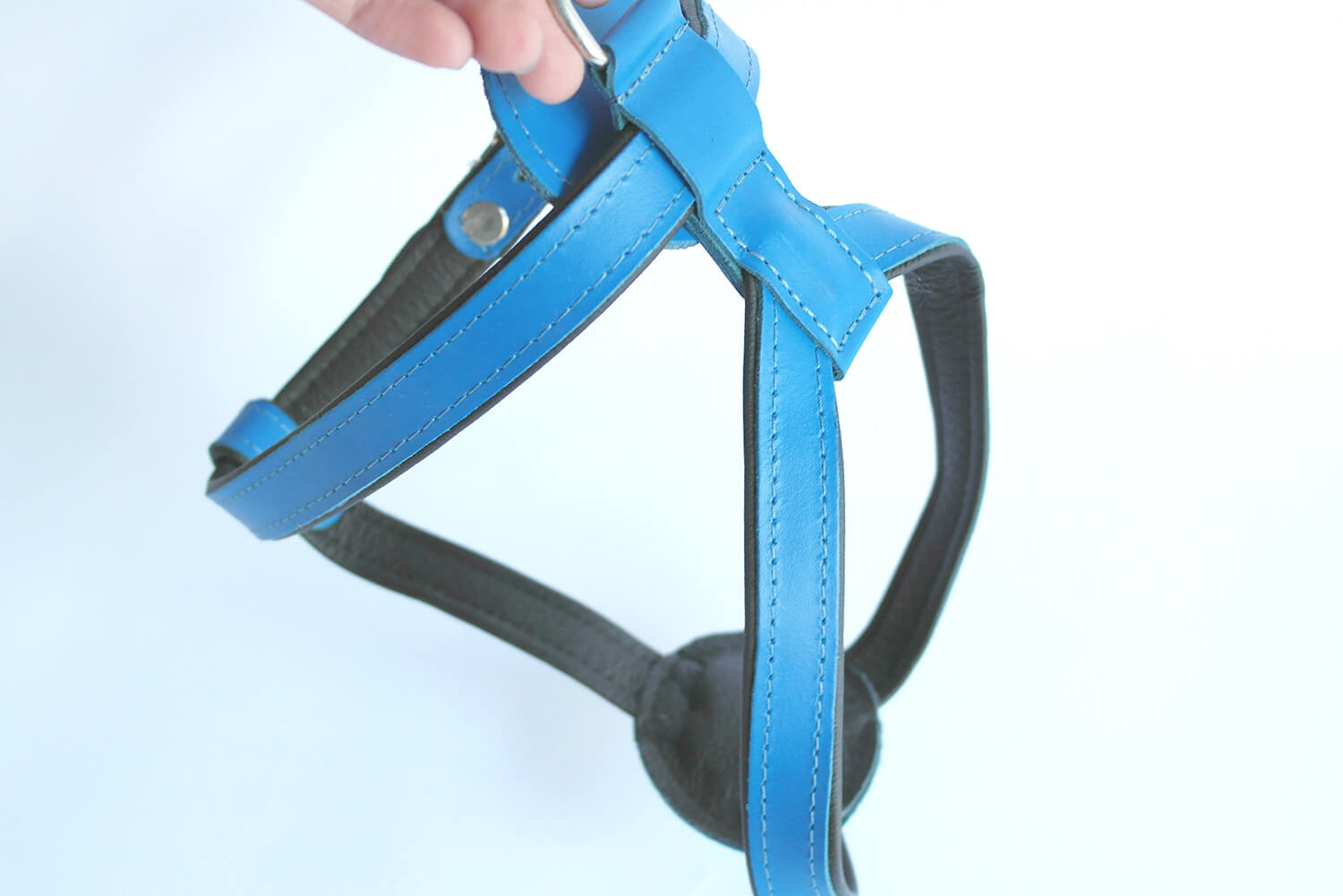July 2, 2014
1 Quick Tip to Stop Unwanted Chewing
I’m absolutely in love with all power chewing dogs – and really all dogs!
But there are a few habits that are unique to power chewers that drive us crazy sometimes.
I have a closet monster of my own. And he likes to chew my most important stuff (usually my high heels, that little turd).
In the beginning, we thought that he was just exploring things because he would put everything in his mouth, but now we know that this is his thing. He is 15 months old and he still chews on just about everything…
After nearly 10 pairs of shoes destroyed, including our guests’ shoes, it was getting old fast!
Dogs are so smart and they can learn anything, they just need a little teaching!
So Here’s the Tip
I put some objects on the floor to make a quick learning game for him.
I started with a toy that called ‘BUNNY.’ I also used the word ‘BONE,’ and using these words I rewarded Dex every time he picked up the right object with a nice treat. This was the starting point.
I then added other toys – and later on some shoes, but this time saying ‘No, Leave it’ whenever he went for the shoe.
I rewarded him if he responded to the command by staying away from the shoe with some treats as well.
The positive reinforcement of rewarding him when he followed my commands allowed him to quickly learn what is okay to chew and what is not okay.
Easy right? so now you go try if you have the same problem and report back.
Have your heard of our Bullymake Boxes?
Join 1000’s of other happy CHEWERS! CLICK BELOW.
Check it Out!
June 23, 2014
4 Tips that Could Save your Bulldog’s Life
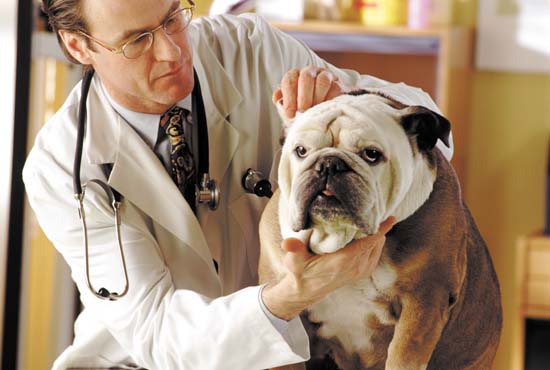
First, let us state that we aren’t veterinarians, always consult with your vet if you have questions. But these will help you!
We all hope that we never have to deal with a life threatening situation. But if it were to happen, would you know what do?
Here are 4 tips that could help save your Bulldog’s life.
1. Know your emergency contact
You never know what is going to happen.
Just the other day I saw my Bulldog smackin’ on a AA-battery that came out of an Xbox controller.
Luckily, he didn’t get into any of the toxins contained inside or even worse – he could have swallowed the whole dang thing.
But if he were to swallow that battery, I would have been prepared.
I know the number and the name of our emergency veterinarian. I know where it is located and how to get there.
As of today I’ve been there twice. He just can’t help but get into things he shouldn’t!
Honestly, if I wasn’t able to react quickly to his situations, he may not be here anymore.
2. Know the signs of overheating and know how to respond
If you didn’t already know, Bulldogs are notoriously bad at cooling themselves down due to their short muzzle and physique.
Bulldogs are a Brachycephalic breed, and breeds of this nature cannot cool down effectively.
Brachycephalic breeds include French, English, American, and Olde English Bulldogs – along with Pugs and Boston Terriers.
Some signs of overheating are heavy panting to the point of heaving, discolored tongue, possible foaming from the mouth, and exhaustion.
Read about overheating and how to prevent it/correct it here.
In a nutshell, cool your dog down (more tips about that in the link), and have some lemon juice handy in case they start choking on their own saliva. Lemon juice will break down the saliva.
See the comments below for our user’s experiences with lemon juice!
3. Know how to apply chest compressions
Freak events do happen, but if it does, knowing how to apply chest compressions to your Bulldog could be life saving.
Events that would require such a maneuver would be sudden unconsciousness and non-response.
Check out this video where this dog’s life is saved by a dog trainer applying CPR – truly incredible (and terrifying):
4. Know how to dislodge an object from your bully’s throat
Okay, if your Bulldogs are anything like mine then you know they can chew on anything and everything.
Like I said above, I caught little Dexter the other day delightfully snacking on a battery.
Had it been caught in his throat, there would have been things I could have done to dislodge the battery.
Option 1 is to grab your Bully by his hind legs when he is on all fours. Then lift his/her hind legs up and tilt them forward to make your pooch do a handstand. This method uses gravity to dislodge the object.
Some people have also had success simply sticking their hands in their bulldogs throat and removing the item. Try the first method initially.
The second method is more dangerous but if nothing is working, it is certainly better than letting your dog choke.
Check it Out!
June 9, 2014
5 Great Activities for Your Bulldog
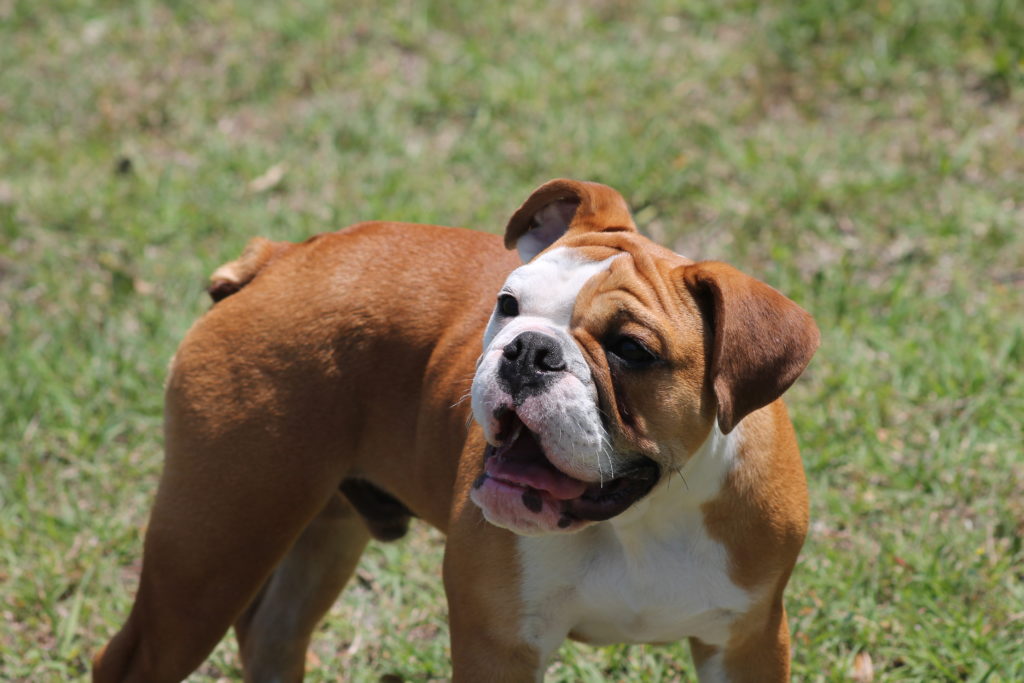
5 Great Activities for Your Bulldog
It seems to me like it is widely assumed that Bulldogs are naturally lethargic animals and don’t need to be involved with any activities.
Well, this really couldn’t be further from the truth! Bulldogs need stimulation in the form of activities whether it is mental or physical. Incorporating these 5 activities into your daily routine can enrich your Bulldog’s life and give him/her some added joy.
So without further ado, let’s take a look at these 5 great activities:
- Hide and Seek: Believe it or not, hide and seek is a great way to exercise your Bulldog physically and mentally. You can hide around trees or in your backyard, or anywhere you see fit. Naturally, most Bulldogs like to follow and seek their humans. This can get your Bulldog running around in the backyard and help challenge their mind while they try and find you.
- Fetch: A classic, playing fetch with your Bully is a great physical activity. Dogs have a natural instinct to hunt or herd, and Bulldogs are no different. Bulldogs were originally bred to herd Bulls! Hence the name. Fetch can get them up and moving and give them an instinctual task.
- New Toys: Just like humans, dogs get bored of toys. They may “figure it out” or chew a toy to death, and after that they simply get bored. Incorporating fresh new toys is a great way to stimulate your Bully mentally. Using a food puzzle toy is also a great way to keep your Bulldog busy. These kind of toys trap treats in them, and your Bulldog must figure out how to get them out!
- Tug-Of-War: A Bulldog favorite, playing tug of war is an excellent way to get some physical activity in for your Bully. If your pup is anything like mine, he could play tug-of-war for days. Just try to keep it indoors on hot days to avoid any kind of overheating issues.
- Walk to New Places: Discovering new places is a great experience for your Bulldog and will keep them happy. Bulldogs are eager to learn, and one way you can help them learn is by allowing them to visit new places! It helps them mature and understand their surroundings. Take your dog out for a walk and let him explore a little bit! Don’t forget to use a Bullymake harness for this one!
So there you have it! 5 easy activities you can do every day with your Bully to keep him/her happy. Enrich your Bulldog’s life with these easy to do tips!
Check it Out!
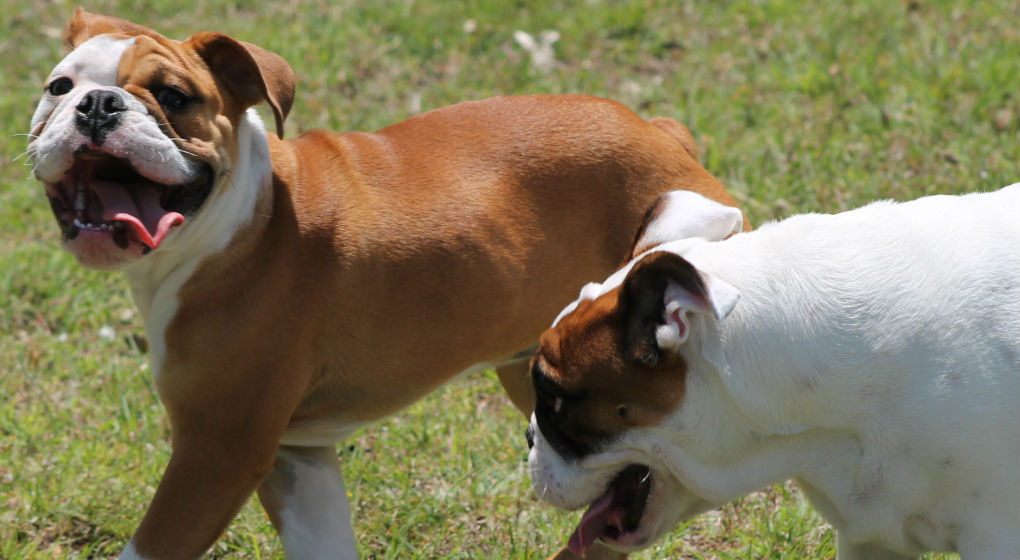
Bulldog Exercise
Bulldogs and exercise are not expected to be synonymous terms.
But maybe they should be.
The thing is, Bulldogs SHOULD exercise. It has substantial benefits that can help your bully with their health – and even increase their span of life.
There isn’t a singular statistic that shows the life expectancy of Bulldogs that exercise vs. ones that don’t (trust me, I searched high and low for that one) But, there is overwhelming evidence of issues that can be avoided by simply exercising your Bully.
We’ll get into the particular exercises you can perform later, but for now, here are some symptoms that you can avoid by exercising your Bulldog, and are commonly seen in many Bulldogs:
-Obesity & Obesity Related Issues
-Heart Disease
-Hip Dysplasia
-Breathing Problems
-Digestive Problems
-Constipation
Texas A&M University even proclaimed that exercise can even help your Bulldog with:
-Improved Bone Health
-Improved Organ Function
-Improved Brain Function
Additional physical benefits include:
-Higher Strength
-Improved Dexterity
-Overall Improved Health
-Improved Sleep
But exercise for Bulldogs doesn’t just stop at physical aspects. There are several mental benefits as well that Bulldog owners may not initially be thinking about. The ASPCA also claims that exercising your Bulldog may limit some issues commonly seen in any dog breed:
-Unruliness
-Hyperactivity
-Play biting
-Barking & Whining
-Predatory Behavior
-Excessive Sexual Urges
-Depression
-Chewing
Exercise for your Bulldog will keep him or her confident, more independent, and less scared when you are not around. It keeps them feeling more secure in general which leads to a happier pup!
So now that we know about the benefits, let’s take a look at good activities and exercises you can perform with your Bully, and for how long.
Notice, these are all LIGHT exercises. We know that Bulldogs are a Brachycephalic breed, so they tend to become overheated easily.
These exercises will keep it light on your Bully:
–Walking: This is an obvious exercise but it is perfect to get your Bulldog up and moving. There are many Bulldogs that get tired out just walking, which will lead to increase cases of hip dysplasia and other health issues. Make sure to use a Bullymake Harness for this one!
–Exercise with a ball: Check out this video of a bulldog on a ball. It may be cute, but it does exercise them! Some Bulldogs love to run around and chase balls, and push it with their nose! This can be a great workout.
https://www.youtube.com/watch?v=Bdj9cViOEuc
–Fetch: Some bulldog even love to play fetch when they are younger (and sometimes older), and it can help tire them out.
–Meet with other Dogs: Bulldogs love to wrestle, especially at younger ages. Socializing with other dogs helps them stimulate their mind and body. It also teaches your Bully correct social skills.
There is no rule of thumb for the longevity of each exercise, but remember to keep an eye on your Bulldog and watch for signs of overheating or breathing problems.
If your Bulldog is already overweight, you’ll need to slowly work them back into an exercise routine.
Start with very brief walks (5 minutes or so) and work your way up with increments of a few minutes each week. This will help build their strength and stamina. Very similar to how you would train a human being.
So get up, and go take your Bully for a walk! it will benefit their mind, body, and soul (and might benefit you too)! And always remember: don’t work them too hard!
Check it Out!
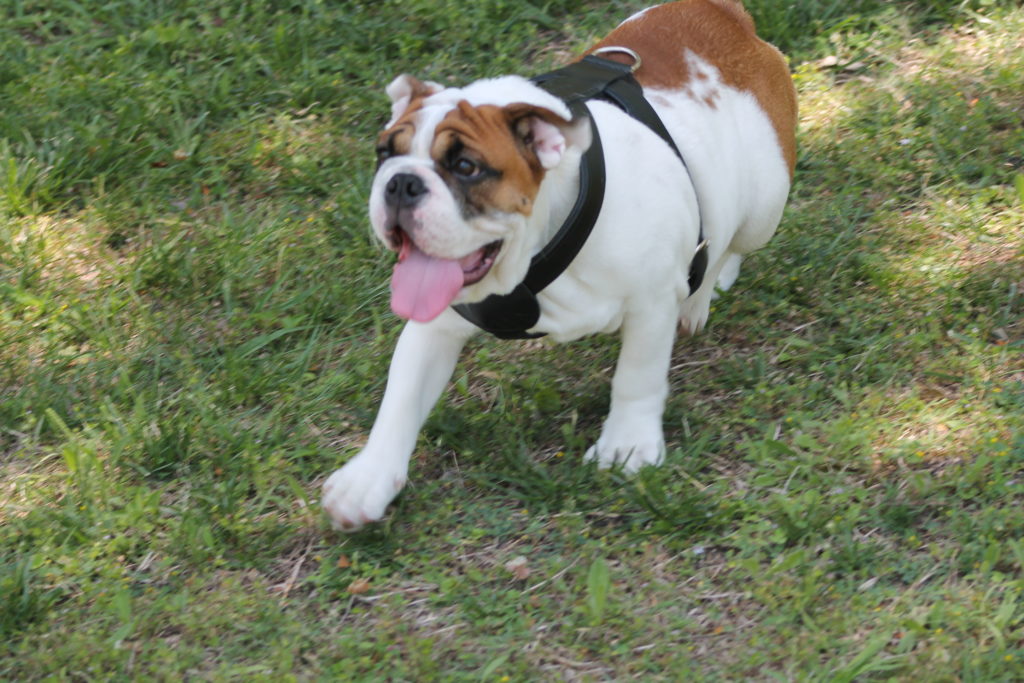
All About the Bulldog Harness
We all know that having a bulldog is a major investment. This is why it is extremely important to know why you need to own a harness, and for what purposes.
Let’s take a quick look all about the harness.
About
The harness is a piece of equipment that has several purposes for your dog, and has multiple designs and uses.
A harness should be worn in conjunction with a collar. The collar and harness have separate purposes, and a responsible owner would own both a harness AND a collar.
For Bulldogs, a harness can be used for walking and training purposes. In fact, you should only use a harness when walking your Bulldog unless it is going to be a very brief walk – (for bathroom use, or something similar in length of time).
Read more about choosing the right collar for your Bully.
Knowing the difference between when to use a collar and when to use a harness is very important for the overall health of your Bulldog.
Bulldogs are 60 pounds of muscle, and allowing them to put all that power on their neck is a mistake that could be deadly for your Bully.
Applying the Harness
A harness is a device that circles around the belly and chest of your Bulldog. This completely avoids your pup’s neck area.
To apply a Bullymake harness, make sure to first open the nickel buckle for easier placement. Place the Bulldog’s head through the front end circle, and then make sure your bulldog steps over the bottom center strap with both legs. Then, reclose the nickel buckle and you are ready to go!
Why a Harness?
Bulldog’s are a brachycephalic breed which means they have a short, compact muzzle and flat face. There are a multitude of issues which these kinds of breeds have to deal with, including overheating.
The reason they overheat is because they have difficulty panting, or breathing.
For this reason, collars are not a good idea to continuously walk your Bully on. You further restrict their breathing and also enhance the risk of tracheal collapse.
Let’s keep your fur-baby safe. Make sure you use a harness when walking!
What is the Best Material?
We firmly believe that leather is the best material for a Bulldog. Leather is softer AND stronger than Nylon, which will give you the added benefit of longevity in the product and also give your Bully more comfort.
Nylon will cut into your Bully and isn’t padded. Our leather harnesses are padded which will decrease tension and cutting into your Bulldog’s skin, fur, and muscle.
Bonus Tip: My Bulldog is Such a Puller, What do I do?
If you aren’t strong enough to handle your Bulldog, you can use techniques to keep your Bulldog in check.
Bulldog’s are natural followers, and most will follow you if you simply let them go and walk away. Sometimes, pulling is not the answer.
Take a quick look at this video where the Bulldog follows the owner!
https://www.youtube.com/watch?v=tdm0nadKldY
See, pulling isn’t always best!
Get Your Bullymake Harness Today By Clicking Below!
Check it Out!

Coconut Oil for Bulldogs
It is widely known that coconut oil has many natural benefits for humans. Well, it also turns out that coconut oil has several benefits for Bulldogs, too.
Coconut oil is an edible oil extracted from the kernel or meat of matured coconuts.
The oil is composed of approximately 91% of saturated fatty acids, 6% of mono-unsaturated fatty acids, and 3% of polyunsaturated fatty acids.
The primary benefits of coconut oil for your Bully come from the oil’s Medium Chain Triglycerides which is often extracted for medicinal purposes. These Medium Chain Triglycerides (MCT’s) have special properties for humans, and because they are able to be rapidly absorbed by the human body, it has shown to benefit many ailments in humans connected with malabsorption.
Okay, okay, that’s a mouthful of science – but how can it help my Bully?
In dogs, MCT’s found in coconut oil can help with weight loss because MCT’s are efficiently metabolized. They also aid in boosting the thyroid, aiding overweight dogs in weight loss and helping the lethargic Bully feel a bit more energetic.
Coconut oil gently raises the metabolism, provides a higher level of energy and vitality, boosts the immune system, improves skin and coat, improves digestion, and reduces allergic reactions.
So, when you’ve tried medication after medication, it may be time to try out nature’s gift to dogs.
Application
You can apply coconut oil either internally to your pup or externally.
When feeding it to your Bully, it would be a good idea to start with 2 teaspoons a day with food, and work your way up if needed. However, 2 teaspoons for an approximately 60 lb. dog should do the trick. Just don’t overload your Bully in the beginning.
Applied externally, you can rub coconut oil on to your dog’s fur and skin and brush them. This can help clear up multiple skin issues that dogs can have, and will keep their coat looking beautiful year-round.
When used regularly, coconut oil can help in the following areas:
Immune System
- Antiviral properties are contained within coconut oil
- Antibacterial properties are contained within coconut oil
- Antifungal properties are contained within coconut oil
- Use coconut oil to prevent any of these kinds of infections
Metabolism
- Helps boost the thyroid to aid in weight loss
- Helps increase energy in otherwise lethargic Bulldogs
Skin and Coat
- Disinfects cuts and promotes wound healing
- Deodorizes a smelly Bully, and helps keep their fur glossy
- Reduces allergic reactions
- Protects from Fleas
- Clears up skin conditions such as eczema
Digestion
- Reduces bad breath
- Improves digestion and nutrient absorption
- Helps other digestive upsets
What kind of Coconut Oil to use?
There are many options to use when it comes to coconut oil, but for Bullies, it is best to use and unrefined coconut oil.
I personally have used Spectrum’s unrefined coconut oil and seen great results in my Bulldogs!
So, why not use coconut oil for your Bulldog? It has TONS of excellent benefits to make your Bully a healthier and happier dog. At worst, your dog may not improve from the use of this supplement. However, it is definitely worth a shot!
Check it Out!
Bulldog Overheating
Summer is around the corner, and being based in Dallas, TX, we here at Bullymake are very aware of what heat can do to your Bulldog. Bulldogs and heat do not mix. And in a state where the temperature can rise upwards of 100 degrees with no problem, it is critical to know the signs of an overheating Bulldog, and what to do about it.
But even if you don’t live in Texas, it is recommended by many veterinarians to keep Bulldogs indoors when it is 85 degrees or hotter outside. Bulldogs have a tendency to overheat easily, as do many brachycephalic breeds. They are not efficient panters, and therefore are not able to cool as easily as other breeds.
First, let’s look over the signs of an overheating Bulldog:
- Excessive panting
- Heaving while panting
- Odd sounds coming from the throat
- Very floppy, loose, discolored tongue
- Possible foaming from the mouth
- Exhaustion from the fight for breath
If you see any of these signs, your Bulldog is likely to be overheating.
This can be a scary situation for any Bulldog owner, as death can occur if not taken care of promptly.
Here are 5 tips to keep your Bulldog cool:
1. Never leave your dog unattended in days of hot weather or while they are in the car. If you do so, it is very possible that they will overheat which could result in death. Also, don’t leave your Bully unattended if you have a pool on a hot day as they could be tempted to jump in. Simply put – keep an eye on your fur-baby when it’s hot.
2. Bulldogs need a cool place to stay and sleep in your home during the summer. Make sure they are always in an air-conditioned and well ventilated room of your house. Tile can help them cool down when it is hot outside.
3. If you see that your Bully is overheating, it is time to cool him off. Remove him from the hot area immediately. Place your bully in some cool water, and pour cool water over his head. If you cannot place him in a tub-like area, hose him down with a low pressure spray. Ensure water reaches and soaks his paws. Make sure he has plenty of cold water to drink.
4. If your Bully is overheated, place your dog by a fan. Use your fingers to spread his fur to open up his coat to help air flow through to his body. Do this after you have put him in the tub/poured cool water on him. Fur acts as an insulator to cold weather so by spreading his/her fur open you are helping to reduce this insulation!
5. Let your Bully see for him/herself how hot it is outside. If your pup is anxious to go on a walk or wants to go outside badly, sometimes it is best for him/her to feel for themselves how hot it is! It’s safe to say your Bully won’t want to be outside for too long when it is scorching outside.
If your Bulldog is overheating on a regular basis, we fully recommend going to see a veterinarian to see if there are any underlying issues.
Comment below now and tell us about any experiences you may have had with Bulldogs in the heat!
Bulldog Cherry Eye
What it is, what the effects are, and how to fix it.
Cherry Eye Description
Unlike humans, dogs have three eyelids. This third eyelid is known as the “nictitating membrane,” and it plays a vital role in the dog’s ability to see by supplying nutrients and oxygen to the eye via tear production.
Cherry eye is simply the non medical term for the prolapsed nictitating membrane – or the third eyelid. Essentially the eyelid, or gland, comes out of place and mispositioned, resulting in a heavily red/pink swollen mass.
Unfortunately for us Bully lovers, this is a common condition found in Bulldogs. Current studies indicate that cherry eye is a genetic problem mostly, but identifying a dog pre-exposed to this issue would be nearly impossible – especially if your breeder was not upfront with you whether or not the mom or dad of your Bully had these similar issues.
Keep in mind that cherry eye is usually seen in younger dogs between the age of 4 months to two years. Typically, owners will experience most of their issues during this time period.
Brachycephalic breeds are most likely to experience issues with their nictitating membrane, hence the common cases of cherry eyes in Bulldogs.
Causes
The third eyelid gland is usually anchored to the lower inner rim of the eyelid by a fibrous attachment. Genetics could be the cause for this particular attachment to be weak, which would increase the chances of cherry eye.
Because it is a congenital issue in Bulldogs, if it happens in one particular eye, it is likely to happen in the other. So be sure to keep a lookout for both eyes if you know your Bully has an issue with one eye.
Once the fibrous attachment becomes weak and breaks, the tear gland moves more freely and causes irritation in the gland even more. This irritation leads to swelling and will eventually form the red/pink swollen mass.
What to Do when Found
It’s best not to wait if you spot cherry eye. Sometimes, cherry eye can correct itself but if it does not, this can lead to worse problems in your Bully. The more swollen and irritated the cherry eye becomes, the more difficult it is to correct. Therefore, seeking the medical expertise of a veterinarian may be your best option.
Treatment
There are several options for treatment which include surgical and non-surgical procedures. Largely this will vary dependent upon the severity of the issues. Let’s take a closer look at what you can do.
Non-Surgical
Non surgical treatment is possible if you detect cherry eye in your Bully early enough in his/her symptoms.
According to the Fundamentals of Veterinary Ophthalmology, Massage treatment can be applied to his/her eye with a downward-diagonal massage of the affected eye towards the Bulldog’s snout. This can effectively return the third eyelid into place and reduce irritation.
There are some medications available to help cure your Bully of their cherry eye symptoms in addition to the eye massaging. See a vet for medication if the situation persists after eye massages.
Occasionally cherry eye can correct itself, but as stated before, this is a gamble not worth taking.
Here is a youtube video of an owner correcting his Bully’s cherry eye. We recommend consulting your Veterinarian before attempting if you are not comfortable doing the procedure.
Surgical Treatment for Cherry Eye
There are surgical options for your Bully’s cherry eye when needed. In fact, this is the most common method to correction.
Check out our article where we talk a little about the cost to this procedure.
In one method, a surgical procedure is completed to effectively replace the third eyelid gland. Replacement of the gland will greatly reduce your dog’s risk to “dry eye” later in life, and tear production should remain similar – if not the same – to previous levels.
In another method, known as the “pocketing method,” requires suturing of tissue around the prolapse and encasing it in a layer of conjunctiva. This is another common method that surgeons will frequently use.
Another procedure is removal of the gland which used to be the old standard. However, today this is not recommended because it has been shown that complete removal of the gland will reduce tear production in the eye. This reduced tear production leads to other issues later in the dog’s life, including “dry eye.”
Consult your vet/surgeon for the best options for your pup.
Share!
We hope this article helped you become a little more informed about cherry eye! If so, please use the social icons below to share our page. Feel free to drop a comment as well if you have any experiences with this known eye issue in Bulldogs.
Check it Out!
April 20, 2014
Bulldog Shedding – The All Inclusive Guide!
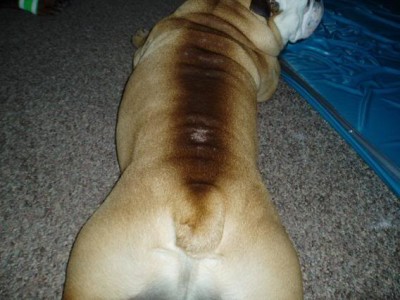
Do Bulldogs Shed?
Well, the simple answer to this question is yes. Bulldogs do shed. But they don’t shed as much as other breeds and when they do shed their hair is less noticeable on the ground, on furniture, and other areas. From my own personal experience, I think bulldog shedding is most noticeable on your dark clothing. Having him or her in your lap while you’re wearing a dark jacket or dark pants will almost positively result in visible Bulldog hair on your clothing. Of course, if your bully has any kind of white coating, the hair is more likely to show. All-in-all, bulldogs can be considered “average” shedders.
Bulldogs have a short, fine, smooth coat. The good news about this is that when they do shed, it can make cleanup a relatively simple job. The coat also matures with age, and a bulldog puppy will typically shed more than the adult version later in their life. As their coat matures, Bulldog shedding should slow down given proper grooming (more on that later)!
What Would Cause my Bulldog to Excessively Shed?
Excessive Bulldog shedding can be due to many reasons. Your veterinarian will be your best option when determining the exact reason that your Bully may be excessively shedding. After all, shedding is normal, and the Vet will be able to determine if the shedding is natural or part of an underlying disorder. According to the ASPCA (American Society for the Prevention of Cruelty to Animals), excessive shedding can be caused by:
- Parasites (fleas, lice or mites)
- Fungal or bacterial infections
- Inhalant or food-related allergies
- Kidney, liver, thyroid or adrenal disease (including Cushing’s)
- Pregnancy or lactation
- Certain medications
- Self-induced trauma due to licking
- Cancer
- Immune disease
- Sunburn
- Contact with irritating or caustic substances
- Improper Nutrition
Often, bulldog shedding can simply be caused by a reaction to food or a result of improper nutrition. The remedy to this issue may be to experiment with different food brands and types, and seeing how your Bulldog reacts. However, sometimes the excessive shedding may warrant a trip to the Vet, especially if you spot signs of skin irritation or redness, open sores, balding, dull and dry hair, persistent scratching and/or licking, and other abnormalities in your Bulldog.
Tips for Decreasing Shedding
There are many tricks and tips that you can do to manage your Bulldog’s shedding. Here are the most vital ones:
Proper Grooming: We recommend brushing your dog every single day. Bulldogs typically love being groomed, especially if it ends with a reward! Teach your dog at a young age to be stable on a grooming table. We recommend using a fine tooth brush with very compact bristles to really remove the loose hair in your Bulldog. Read about the costs involved with grooming.
Bathe your Dog as Needed: Nobody like a smelly Bully! If you see that your dog is getting dirty, or he’s been rolling around outside a bit too much, it’s a good idea (and a necessity) for you to bathe your dog. Be sure to reward him/her after their bath.
Feed a nutritious Dog food: Make sure you watch for signs in your Bully when using a new food or feeding him something for the first time. If the dog has any sort of negative reactions, it may be time to switch up what he eats.
Invest in a proper collar: A poor collar can cause allergic reactions or make your Bully scratch his neck area more than usual. Check out our shop for more on that!
Invest in a Decent Vacuum: Vacuuming your house will keep allergens from dog hair off the ground and furniture, and overall improve the health of your home.
Use A Fatty Acid Supplement: Omega 3 and 6 fatty acids have been proven to help the coat of Bulldogs and lessen shedding. You can buy this in the form of Salmon oil or in other dietary supplements.
Share!
Comment below if you have any personal experiences with Bulldog shedding. If you liked the article, help us out by sharing on Facebook, Twitter, Reddit, or any of your favorite social media!
Do you have a heavy chewer? Check out our dog subscription box.
